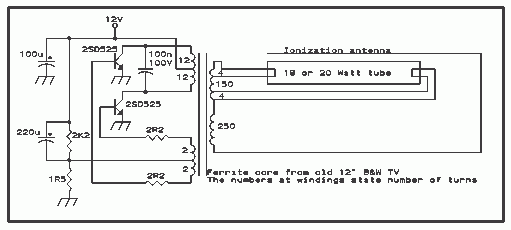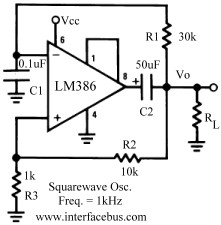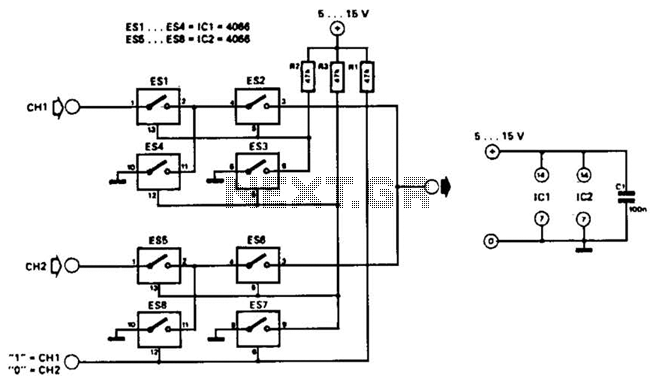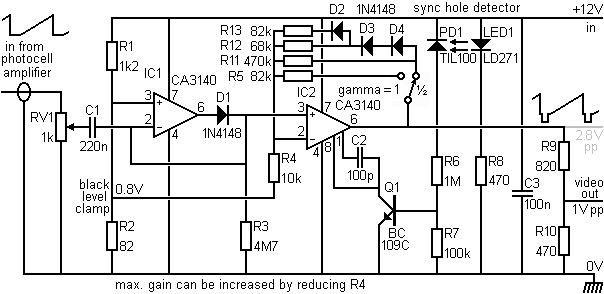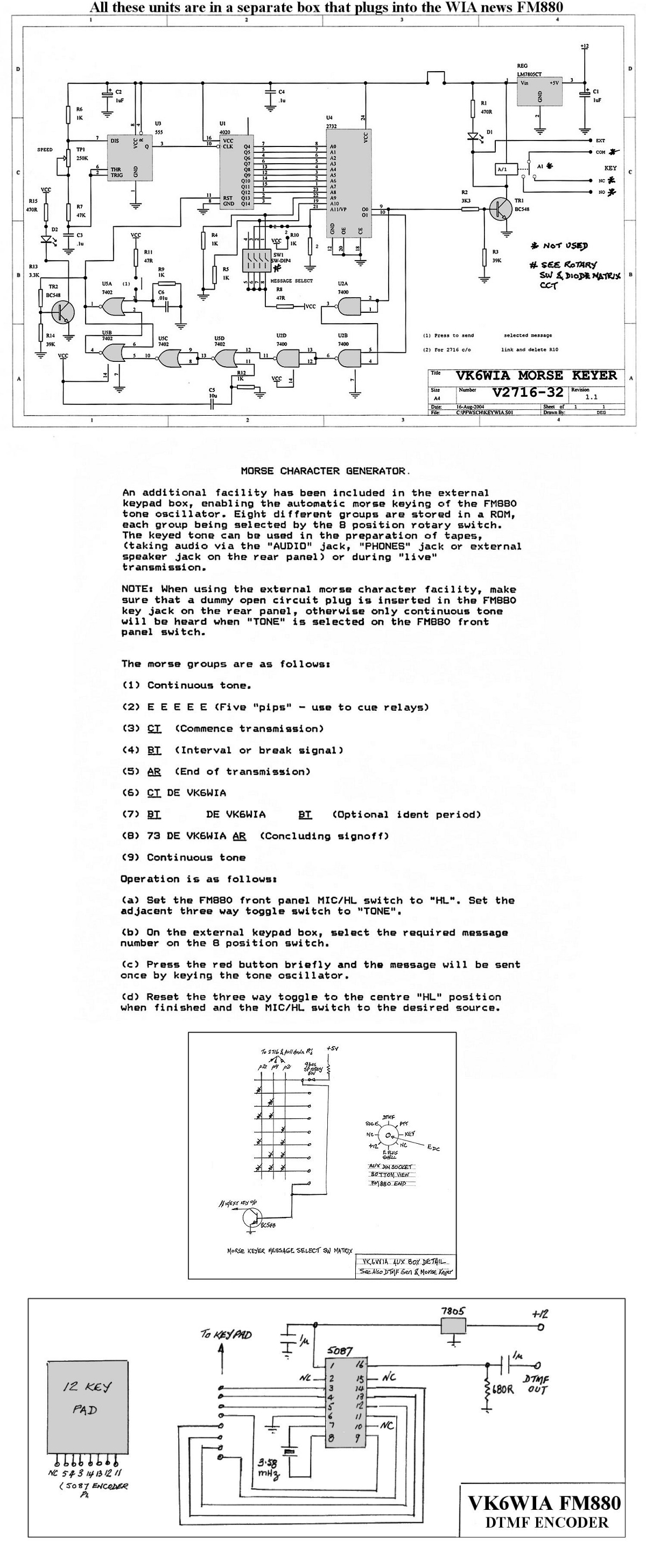
Video circuits
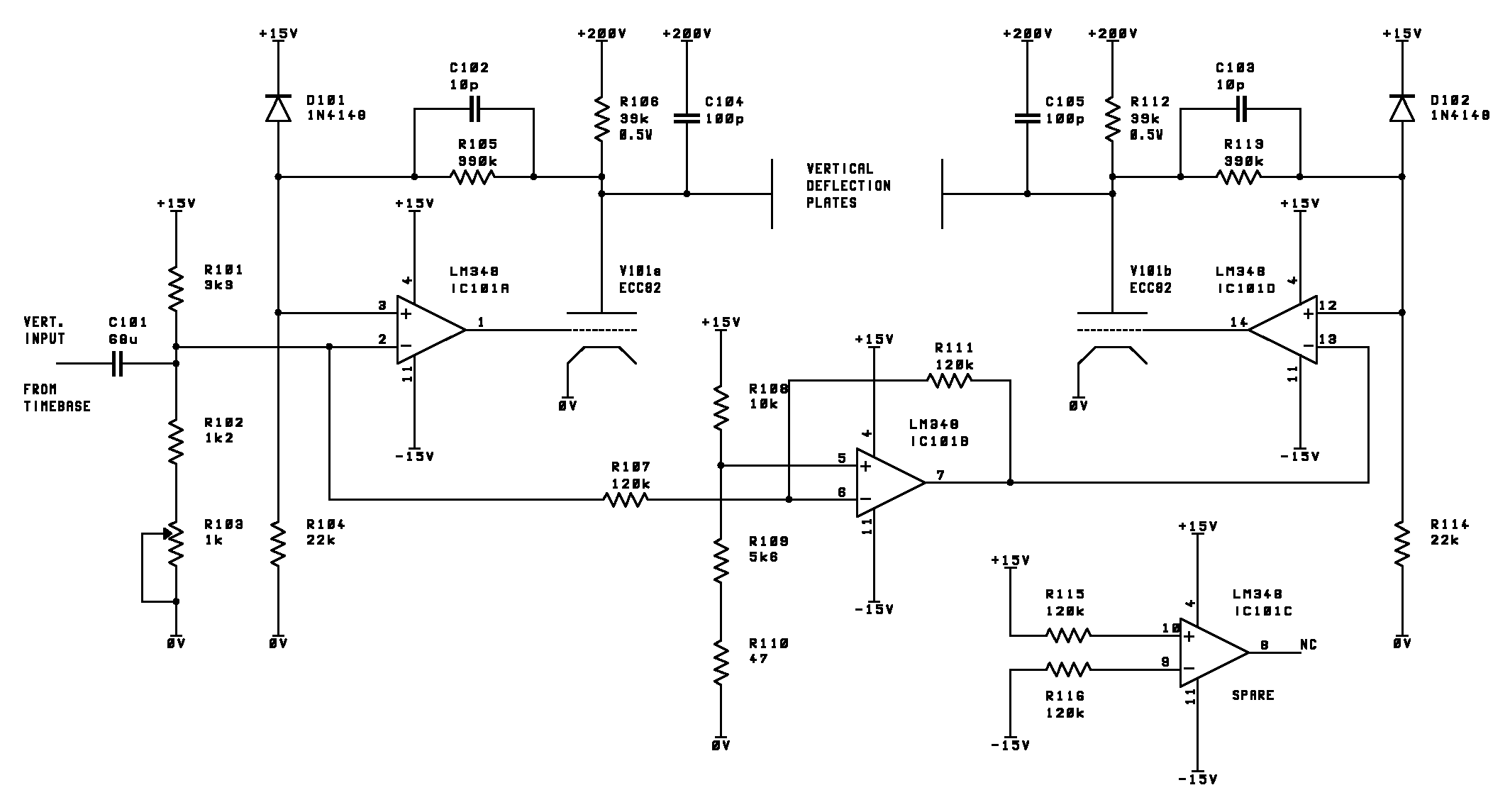
This page outlines the development of electronics for displaying a monochrome video image on an electrostatic oscilloscope tube. This work complements the Electron Optics section in the Experiments category. The primary objective is to showcase a moving video image using a completely homemade cathode ray gun within a vacuum rig's bell jar. The chosen oscilloscope tube is a 1950s RCA 3RP1-A, which closely matches the specifications of the homemade electron gun, making it well-suited for the electronic development. The circuit is intended for use with a PAL composite video signal, with potential adaptability for NTSC or SECAM by modifying certain component values, particularly the ramp rates of the sweep integrators. A Sanyo LA7801 synchronization and deflection IC was selected, as it was the most appropriate part available that had a data sheet. Although this part is obsolete, it can likely be sourced from old televisions. Other timebase ICs may be utilized with suitable circuit modifications. The circuit design closely follows the schematic in the data sheet. The line pulse output at pin 4 of the LA7801 generates a 2V, 25µs positive rectangular pulse, with the rising edge marking the start of the line. The field pulse output at pin 6 produces a 3V, 1.5ms positive rectangular pulse coinciding with the field blanking period. The integrators ramp freely until reset by FETs (TR1 and TR2), creating the necessary sawtooth sweep waveforms. A PAL line duration is 64µs, allowing the horizontal integrator to ramp to 9.6V before resetting, while a field lasts 20ms, enabling the vertical integrator to ramp to 9.4V before resetting. Potentiometers R23 and R28 adjust the horizontal and vertical picture size. The oscillograph illustrates the horizontal scan integrator's operation, with traces representing various signals. The video amplifier is discussed later. The square pulses in the video waveform represent line synchronization pulses, extracted by the sync separator in the timebase (IC1) to synchronize the horizontal sweep. The RCA tube features a vertical deflection factor of 52 to 70V per inch per kV of accelerating voltage, necessitating a high-voltage drive. An ECC81 double triode valve was selected for the high-voltage output, with operational amplifiers in the feedback loop to enhance linearity and set voltage gain. Resistors R105 and R104 provide feedback from valve V101a, with the anode voltage divided by 19 and fed back to the op-amp. Resistors R101, R102, and R103 adjust the op-amp IC101A inputs to approximately 5.3V, setting the anode voltage to around 100V (half the high tension voltage). Potentiometer R103 modifies the horizontal picture position, while D101 safeguards the op-amp. Capacitors C102 and C104 ensure high-frequency stability. IC101B and associated resistors invert the input signal and direct it to a second valve output stage comprising V101b and IC101D. The horizontal deflection plates connect to the valve anodes and are driven in bridge mode, delivering a differential drive of nearly 400V peak-to-peak from a 200V supply. Another ECC81 double triode is employed for the high-voltage output. The LM348 op-amp initially used in the vertical amplifier lacked sufficient bandwidth for the horizontal amplifier, prompting a replacement with the LF347, which provides adequate bandwidth.
The schematic design incorporates various components that work together to facilitate the display of a monochrome video image on the oscilloscope tube. The synchronization and deflection IC (LA7801) plays a central role in generating the necessary timing signals for horizontal and vertical sweeps. The integration of FETs for resetting the integrators ensures that the sawtooth waveforms are produced accurately, which is critical for maintaining the integrity of the video signal being displayed.
The feedback mechanism involving the ECC81 valve and operational amplifiers is crucial for stabilizing the output and enhancing the linearity of the deflection system. This is particularly important given the high voltage requirements of the RCA tube, which necessitates careful management of the output to prevent distortion in the displayed image. The use of potentiometers for adjusting picture size and position allows for fine-tuning of the display, accommodating variations in the input signal and user preferences.
In conclusion, the described circuit is a sophisticated integration of various electronic components, designed to achieve the goal of displaying a monochrome video image on an oscilloscope tube. The careful selection of parts, attention to timing and synchronization, and the implementation of feedback mechanisms are all critical elements that contribute to the successful operation of this electronic system.This page describes the development of electronics to display a monochrome video image on an electrostatic oscilloscope tube. This work is complementary to the Electron Optics page in the Experiments section. The ultimate goal is to display a moving video picture on a completely home made cathode ray gun inside the bell jar of a vacuum rig.
For th is reason I chose to use a 1950`s RCA 3RP1-A oscilloscope tube. It is very similar in specification to my homemade electron gun and so is well suited to the development of the electronics. It should ultimately be possible to disconnect the RCA tube and connect the homemade one. The circuit is designed for use with a PAL composite video signal, but it should be possible to adapt it for use with NTSC or SECAM by changing a few component values.
In particular, the ramp rates of the sweep integrators may need to be adjusted slightly. I chose to use a Sanyo LA7801 synchronization and deflection IC. This was the most suitable part in my bits box for which I could obtain a data sheet. This part is obsolete but could probably be obtained from an old television. Other timebase ICs could be used with appropriate alteration of the circuit. The circuit is closely based upon that provided in the data sheet. Click on the schematic below to see it in higher resolution. The line pulse output at pin 4 of the LA7801 consists of a 2V, 25us long positive rectangular pulse. The rising edge coincides with the start of the line. The field pulse output at pin 6 consists of a 3V, 1. 5ms long positive rectangular pulse which coincides with the field blanking period. The integrators (below) ramp freely until reset by the FETs (TR1 and TR2). This gives the required `saw tooth` sweep waveforms. One PAL line lasts 64us, so the horizontal integrator ramps to 9. 6V before resetting. A field (there are two fields to a frame) lasts 20ms, so the vertical integrator ramps to 9. 4V before resetting. Potentiometers R23 and R28 set the horizontal and vertical picture size. The oscillograph below shows the operation of the horizontal scan integrator. The probes used were x10. From top to bottom, the traces are IC1 pin 4 (2V / division), TR1 gate (5V / division), IC3 pin 6 (10V / division) and the video signal at IC301 pin 6 (1V / division). The video amplifier is described later. The square pulses in the video waveform are the line synchronization pulses and are extracted by the sync separator in the timebase (IC1) to lock the horizontal sweep.
The RCA tube has a vertical deflection factor of 52 to 70V per inch per kV of accelerating voltage, so a high voltage drive is required. An ECC81 double triode valve was chosen for the high voltage output. Operational amplifiers in the feedback improve the linearity and set the voltage gain. Click on the schematic below to see it in higher resolution. R105 and R104 provides the feedback from valve V101a. The anode voltage is divided by 19 and fed back to the op-amp. R101, R102 and R103 set the inputs of op-amp IC101A to around 5. 3V. Thus the anode voltage is set to about 100V (half the HT voltage). Potentiometer R103 adjusts the horizontal picture position. D101 protects the op-amp. C102 and C104 are for high frequency stability. IC101B and associated resistors invert the input signal and apply it to a second valve output stage comprising V101b and IC101D.
The horizontal deflection plates are connected to the valve anodes and are driven in bridge mode. This provides a differential drive of almost 400V peak to peak from a 200V supply. IC101C is not used. An ECC81 double triode is again used for the high voltage output. The bandwidth of the LM348 op-amp used in the vertical amplifier proved to be inadequate for the horizontal amplifier and so it was replaced by an LF347. The LF347 has adequate bandwidth and I happened to have some in my bits box. Click on the schematic below to see it in higher resolution. The values of C 🔗 External reference
The schematic design incorporates various components that work together to facilitate the display of a monochrome video image on the oscilloscope tube. The synchronization and deflection IC (LA7801) plays a central role in generating the necessary timing signals for horizontal and vertical sweeps. The integration of FETs for resetting the integrators ensures that the sawtooth waveforms are produced accurately, which is critical for maintaining the integrity of the video signal being displayed.
The feedback mechanism involving the ECC81 valve and operational amplifiers is crucial for stabilizing the output and enhancing the linearity of the deflection system. This is particularly important given the high voltage requirements of the RCA tube, which necessitates careful management of the output to prevent distortion in the displayed image. The use of potentiometers for adjusting picture size and position allows for fine-tuning of the display, accommodating variations in the input signal and user preferences.
In conclusion, the described circuit is a sophisticated integration of various electronic components, designed to achieve the goal of displaying a monochrome video image on an oscilloscope tube. The careful selection of parts, attention to timing and synchronization, and the implementation of feedback mechanisms are all critical elements that contribute to the successful operation of this electronic system.This page describes the development of electronics to display a monochrome video image on an electrostatic oscilloscope tube. This work is complementary to the Electron Optics page in the Experiments section. The ultimate goal is to display a moving video picture on a completely home made cathode ray gun inside the bell jar of a vacuum rig.
For th is reason I chose to use a 1950`s RCA 3RP1-A oscilloscope tube. It is very similar in specification to my homemade electron gun and so is well suited to the development of the electronics. It should ultimately be possible to disconnect the RCA tube and connect the homemade one. The circuit is designed for use with a PAL composite video signal, but it should be possible to adapt it for use with NTSC or SECAM by changing a few component values.
In particular, the ramp rates of the sweep integrators may need to be adjusted slightly. I chose to use a Sanyo LA7801 synchronization and deflection IC. This was the most suitable part in my bits box for which I could obtain a data sheet. This part is obsolete but could probably be obtained from an old television. Other timebase ICs could be used with appropriate alteration of the circuit. The circuit is closely based upon that provided in the data sheet. Click on the schematic below to see it in higher resolution. The line pulse output at pin 4 of the LA7801 consists of a 2V, 25us long positive rectangular pulse. The rising edge coincides with the start of the line. The field pulse output at pin 6 consists of a 3V, 1. 5ms long positive rectangular pulse which coincides with the field blanking period. The integrators (below) ramp freely until reset by the FETs (TR1 and TR2). This gives the required `saw tooth` sweep waveforms. One PAL line lasts 64us, so the horizontal integrator ramps to 9. 6V before resetting. A field (there are two fields to a frame) lasts 20ms, so the vertical integrator ramps to 9. 4V before resetting. Potentiometers R23 and R28 set the horizontal and vertical picture size. The oscillograph below shows the operation of the horizontal scan integrator. The probes used were x10. From top to bottom, the traces are IC1 pin 4 (2V / division), TR1 gate (5V / division), IC3 pin 6 (10V / division) and the video signal at IC301 pin 6 (1V / division). The video amplifier is described later. The square pulses in the video waveform are the line synchronization pulses and are extracted by the sync separator in the timebase (IC1) to lock the horizontal sweep.
The RCA tube has a vertical deflection factor of 52 to 70V per inch per kV of accelerating voltage, so a high voltage drive is required. An ECC81 double triode valve was chosen for the high voltage output. Operational amplifiers in the feedback improve the linearity and set the voltage gain. Click on the schematic below to see it in higher resolution. R105 and R104 provides the feedback from valve V101a. The anode voltage is divided by 19 and fed back to the op-amp. R101, R102 and R103 set the inputs of op-amp IC101A to around 5. 3V. Thus the anode voltage is set to about 100V (half the HT voltage). Potentiometer R103 adjusts the horizontal picture position. D101 protects the op-amp. C102 and C104 are for high frequency stability. IC101B and associated resistors invert the input signal and apply it to a second valve output stage comprising V101b and IC101D.
The horizontal deflection plates are connected to the valve anodes and are driven in bridge mode. This provides a differential drive of almost 400V peak to peak from a 200V supply. IC101C is not used. An ECC81 double triode is again used for the high voltage output. The bandwidth of the LM348 op-amp used in the vertical amplifier proved to be inadequate for the horizontal amplifier and so it was replaced by an LF347. The LF347 has adequate bandwidth and I happened to have some in my bits box. Click on the schematic below to see it in higher resolution. The values of C 🔗 External reference
